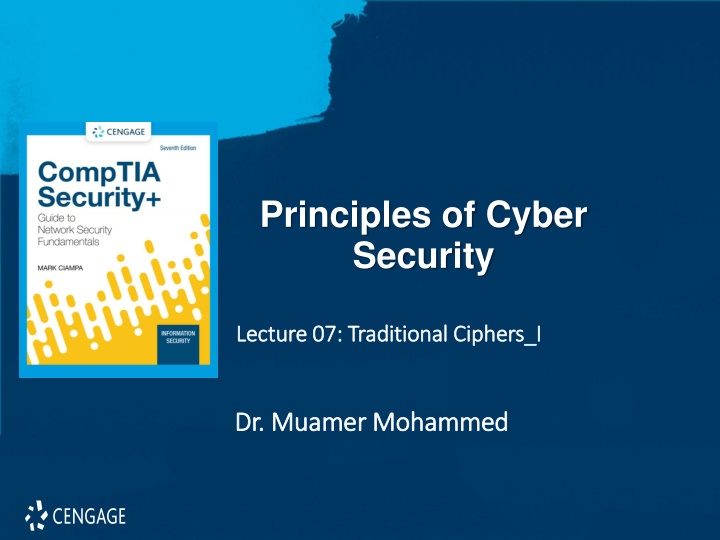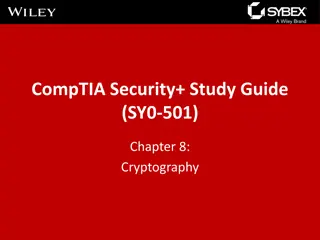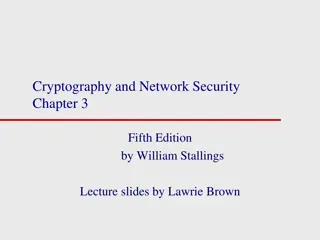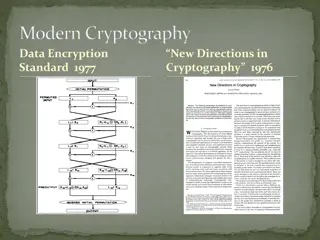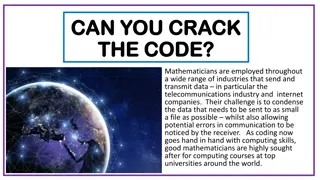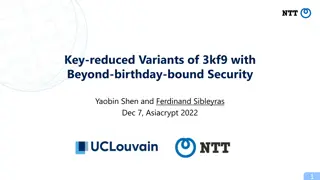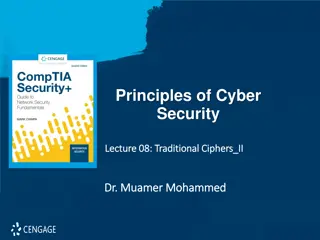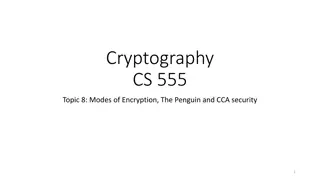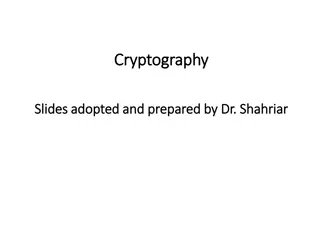Traditional Ciphers and Transposition Techniques
Dive into the world of traditional ciphers and explore the implementation of transposition techniques like Rail Fence Cipher and Simple Columnar Transpositions. Understand how these methods rearrange plaintext messages to enhance security and confidentiality in communication. Discover the principles behind these cryptographic algorithms through practical examples and explanations.
Download Presentation

Please find below an Image/Link to download the presentation.
The content on the website is provided AS IS for your information and personal use only. It may not be sold, licensed, or shared on other websites without obtaining consent from the author.If you encounter any issues during the download, it is possible that the publisher has removed the file from their server.
You are allowed to download the files provided on this website for personal or commercial use, subject to the condition that they are used lawfully. All files are the property of their respective owners.
The content on the website is provided AS IS for your information and personal use only. It may not be sold, licensed, or shared on other websites without obtaining consent from the author.
E N D
Presentation Transcript
Principles of Cyber Security Lecture Lecture 07 07: : Traditional Traditional Ciphers_I Ciphers_I Dr. Dr. Muamer Muamer Mohammed Mohammed 1
Objectives 7.1 Explain how to implement cryptography Describe the traditional ciphers 7.2 algorithms (transposition algorithms).
Transposition Ciphers Transposition Ciphers are ciphers in which the plaintext message is rearranged by some means agree upon by the sender and receiver. 3
Simple Types of Transposition Ciphers Rail Fence Cipher: write the plaintext in a zig-zag pattern in two rows and form the ciphertext by reading off the letters from the first row followed by the second. 4
Transposition Ciphers Example 1: Encipher CHUCK NORRIS IS A TOUGH GUY using a rail fence cipher. Solution: 5
Transposition Ciphers Note: to decipher a rail fence cipher, we divide the ciphertext in half and reverse the order of the steps of encipherment, that is, write the ciphertext in two rows and read off the plaintext in a zig-zag fashion. 6
Simple Columnar Transpositions Where the message is written horizontally in a fixed and agreed upon number of columns and then described letter by letter from the columns proceeding from left to right. The rail fence cipher is a special example. 7
Simple Columnar Transpositions Plain Text Cipher Text T S S O H O A N I W H A A S O L R S T O I M G H W U T P I R S E E O A M R O O K I S T W C N A S N S T H I S I S A M E S S A G E T O S H O W H O W A C O L U M N A R T R A N S P O S I T I O N W O R K S 8
Simple Columnar Transpositions Example 3: Encipher THE JOKER SAID THAT IT WAS ALL PART OF THE PLAN using a simple 5 column transposition cipher. Solution: 9
Simple Columnar Transpositions Example 4: Suppose we want to decipher TOTBA AUJAA KMHKO ANTAU FKEEE LTTYR SRLHJ RDMHO ETEII Solution: 10
Summary Cryptography that is improperly applied can lead to vulnerabilities that will be exploited. In transposition Cipher Technique, plain text characters are rearranged with respect to the position. Columnar Transposition has the security of a transposition cipher with the extra benefit of utilizing a keyword. Columnar Transposition involves writing the plaintext out in rows, and then reading the ciphertext off in columns one by one. 11
Thank you 12
